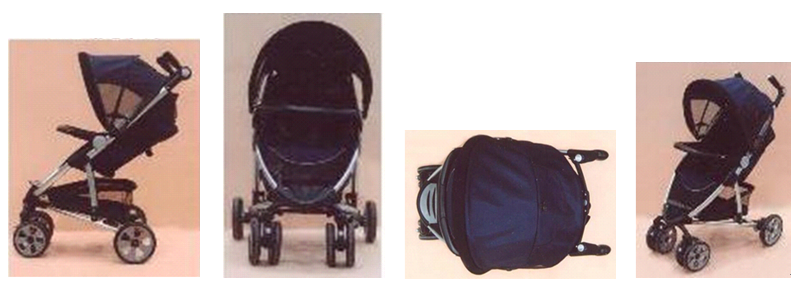
Jiangsu High Court confirmed that for an action to be constituted as infringement, it does not require a design to be fully copied. It is sufficient if the “grant characters” contained in the contested product significantly affect the overall impression thereof.
In the case at hand, the contested product is a baby stroller pictured below:

The plaintiff claimed that such baby stroller infringed on their design no. 200530080993.x as follows:

As can be seen, the contested product is different from the design in many ways. The basket is rectangular in the product but triangular in the design; there is only one front wheel in the baby stroller while a pair of front wheels are provided in the design; the front wheel frame and back wheel frame are connected by a cross rod in the baby stroller while the frames are connected by two vertical bars in the design.
However, the court of first instance deemed that the distinctions above either cannot be observed during the normal use or are not significant enough to markedly influence the overall impression of common consumers, and thus held that the baby stroller falls into the protection scope of the design.
The appellate court, Jiangsu High Court, maintained the first instance decision but based on different grounds. The court first defined three new concepts: grant character, reference character and avoidance character. The grant characters refer to characters which distinguish a design from prior arts and thus enable the design to be granted; reference characters are the characters contained in a contested product which are identical to the grant characters of a design; and avoidance characters are characters in a contested product which differ from the design. The court believed whether a contested product constitutes an infringement of a design depends on how much influence is created by the reference characters on the overall appearance of such product. If the contested product contains all grant characters of the design and the avoidance characters are too minor to create obvious differences to the overall appearance, or the avoidance characters belong to common designs or could not be observed during normal use, or the avoidance characters cannot create an individual visual impression, then the reference characters are more influential and thus result in a design infringement.
In the case at issue, the appellate court identified the reference characters of the contested product on the basis of invalidation decision no. 19851, in which the Patent Re-examination Board (PRB) assessed 9 distinctions between the design and the prior arts: the basic shape of the stroll frame, the connection of the front wheel frame and the handrail, the shape of the rear wheel frame, the handrail, the foot pad, the basket, the handle etc. The court confirmed that 6 of them are grant characters but only 3 grant characters were referred to in the contested product which could be observed easily: the basic shape of the stroll frame, the handrail and the handle.
The court then distinguished the avoidance characters of the product based on another invalidation request, no. 27377, in which the PRB found that the design differs from the evidence in many ways: the baby stroller shown in the evidence has a double front wheel and two single rear wheels forming a triangle structure; there are three spokes in the rub; the basket is rectangular and is set under the seat; a beam is provided between the two handrails; and the right and left side of the visor are mesh. Given that the stroller in the evidence is identical to the contested product, the court confirmed that the abovementioned 5 differences are the avoidance characters of the contested product.
Weighing the influences created by the reference characters and avoidance characters, the court held that the reference characters are more influential to the overall impression of the contested product. In light of the reasoning above, the court affirmed the first instance judgment.
Counsel comment:
The reasoning behind the Jiangsu High Court’s decision is in line with Article 11 of the Interpretations of the Supreme People’s Court on Certain Issues Concerning the Application of Law in the Trial of Patent Infringement Cases, which states that factors different from existing designs are more likely to affect the overall visual effect of a design. However, it is not easy to pick up such factors from others since no substantive examination is required for design patent. To assist the courts in identifying grant characters, a plaintiff could provide plenty of favourable prior arts in the field. Relevant Patent Evaluation Reports, re-examination decisions, invalidation decisions and previous judgments of the same design would be also helpful for the assessment in a design infringement case.


Follow us






